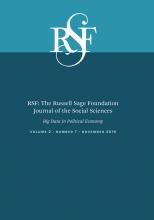Research Article
Open Access
Data Science and Political Economy: Application to Financial Regulatory Structure
Sharyn O’Halloran, Sameer Maskey, Geraldine McAllister, David K. Park, Kaiping Chen
RSF: The Russell Sage Foundation Journal of the Social Sciences November 2016, 2 (7) 87-109; DOI: https://doi.org/10.7758/RSF.2016.2.7.06
Sharyn O’Halloran
aGeorge Blumenthal Professor of Political Economy and professor of international and public affairs at Columbia University
Sameer Maskey
bAssistant professor at Columbia University
Geraldine McAllister
cSenate director at Columbia University
David K. Park
dDean of Strategic Initiatives at Columbia University
Kaiping Chen
eDoctoral student at Stanford University

REFERENCES
- ↵
- Alesina, Alberto, and
- Guido Tabellini
- ↵
- Alonso, Ricardo, and
- Niko Matouschek
- ↵Barth, James R., Gerard Caprio Jr., and Ross Levine. 2006. Rethinking Banking Regulation: Till Angels Govern. New York: Cambridge University Press.
- ↵
- Bendor, Jonathan, and
- Adam Meirowitz
- ↵
- Carlson, Melissa D. A., and
- R. Sean Morrison
- ↵
- Clark, William Roberts, and
- Matt Golder
- ↵Epstein, David and Sharyn O’Halloran. 1999. Delegating Powers. New York: Cambridge University Press.
- ↵
- Fiorina, Morris P
- ↵
- Fiorina, Morris P
- ↵
- Gailmard, Sean
- ↵
- Gailmard, Sean, and
- John W. Patty
- ↵
- ↵Groll, Thomas, Sharyn O’Halloran, and Geraldine McAllister. 2014. “Delegation and the Regulation of Finance in the United States Since 1950.” Working paper. New York: Columbia University.
- ↵Hall, M. A. 1998. “Correlation-Based Feature Subset Selection for Machine Learning.” PhD thesis. University of Waikato.
- ↵
- ↵
- Kroszner, Randall S., and
- Philip E. Strahan
- ↵
- Lapinski, John S
- ↵Lewis, David. 2014. “Supervised Learning in Civil Litigation: A Case Study.” Working paper. Washington, D.C.: American Association for the Advancement of Science.
- ↵Lowi, Theodore. 1979. The End of Liberalism: The Second Republic of the United States. 2nd ed. New York: W. W. Norton.
- ↵Macey, Jonathan R., Geoffrey P. Miller, and Richard Scott Carnell. 2001. Banking Law and Regulation. New York: Aspen Publishers.
- ↵
- Maskin, Eric, and
- Jean Tirole
- ↵Mayhew, David R. 2005. Divided We Govern: Party Control, Lawmaking, and Investigations, 1946–2002. New Haven, Conn.: Yale University Press.
- ↵
- McCubbins, Mathew D
- ↵
- McCubbins, Matthew D.,
- Roger Noll, , and
- Barry Weingast
- ↵
- McCubbins, Matthew D.,
- Roger Noll, , and
- Barry Weingast
- ↵
- McCubbins, Matthew D., and
- Thomas Schwartz
- ↵
- Melumad, Nahum D., and
- Toshiyuki Shibano
- ↵
- Moe, Terry M
- ↵
- Morgan, Donald
- ↵Philippon, Thomas, and Ariell Reshef. 2009. “Wages and Human Capital in the U.S. Financial Industry: 1909–2006.” Working Paper 14644. Cambridge, Mass.: National Bureau of Economic Research.
- ↵
- Robertson, S. E., and
- K. Sparck Jones
- ↵
- Stigler, George J
- ↵Sundquist, James L. 1981. The Decline and Resurgence of Congress. Washington, D.C.: Brookings Institution.
- ↵Tirole, Jean. 2006. The Theory of Corporate Finance. Princeton, N.J.: Princeton University Press.
- ↵
- ↵
- Volden, Craig
- ↵Volden, Craig, and Alan Wiseman. 2011. “Formal Approaches to the Study of Congress.” In The Oxford Handbook of the American Congress, edited by Eric Schickler and Frances E. Lee. Oxford: Oxford University Press.
- ↵
- Wiseman, Alan E
In this issue
Data Science and Political Economy: Application to Financial Regulatory Structure
Sharyn O’Halloran, Sameer Maskey, Geraldine McAllister, David K. Park, Kaiping Chen
RSF: The Russell Sage Foundation Journal of the Social Sciences Nov 2016, 2 (7) 87-109; DOI: 10.7758/RSF.2016.2.7.06
Jump to section
Related Articles
- No related articles found.
Cited By...
- No citing articles found.





